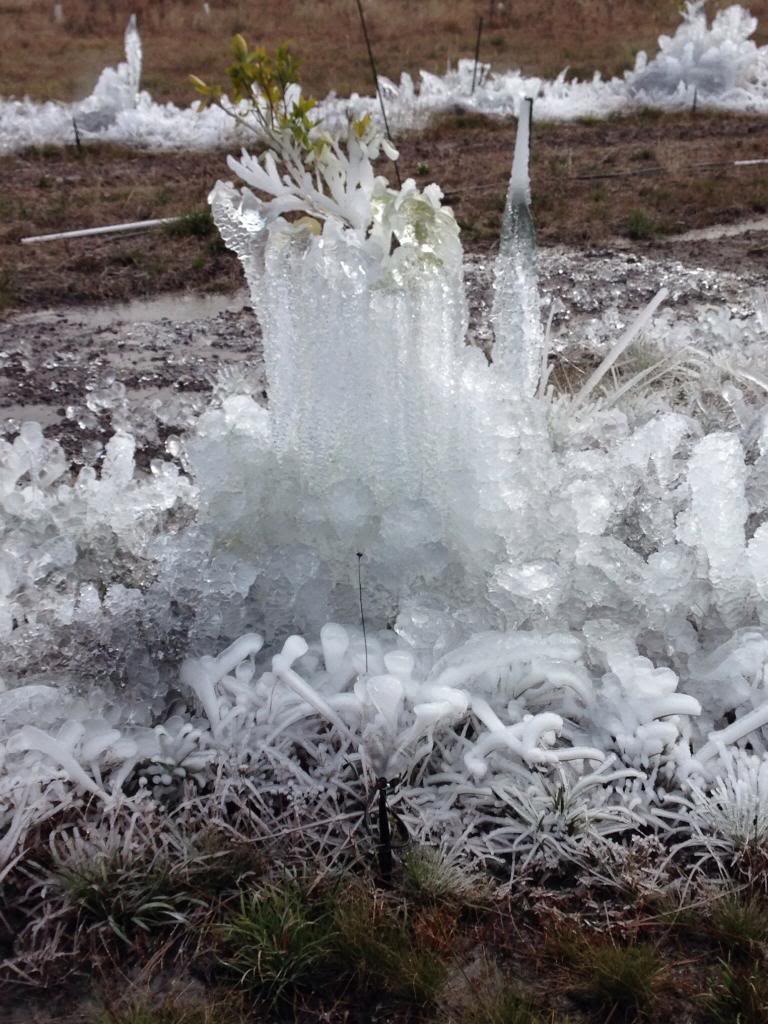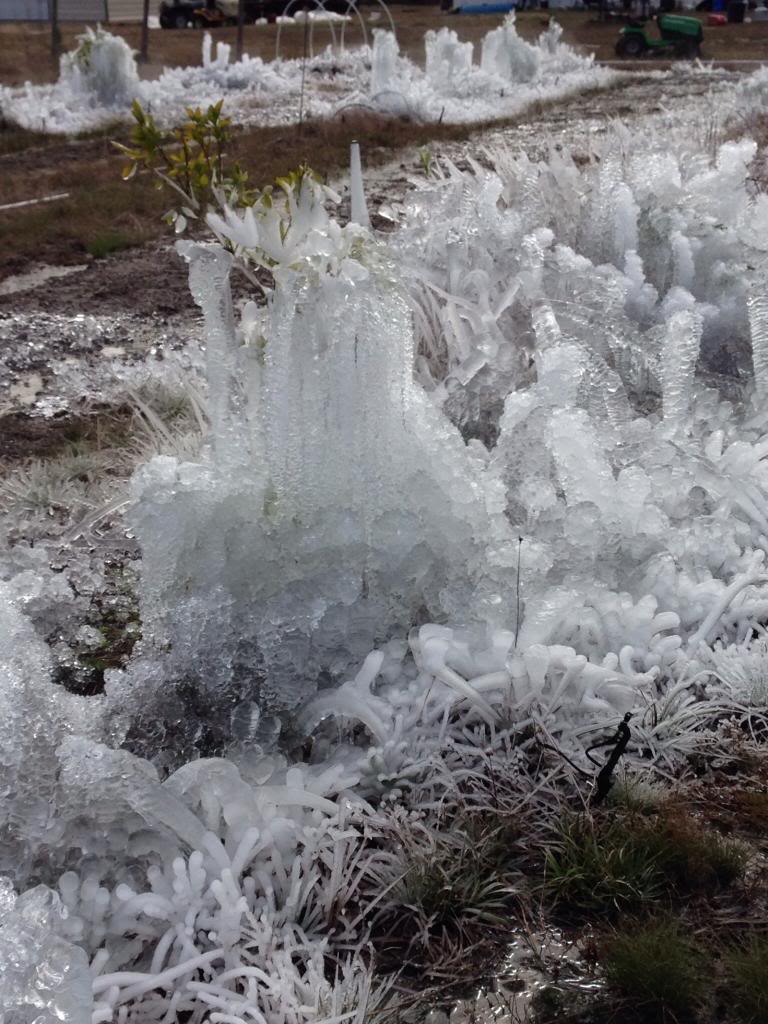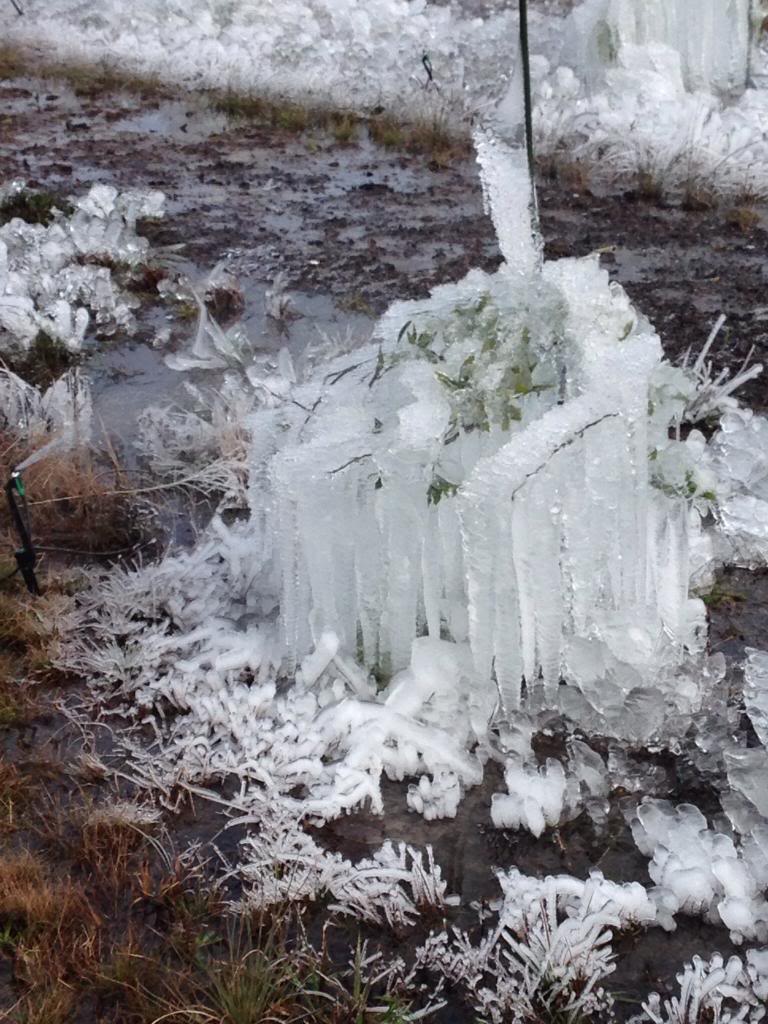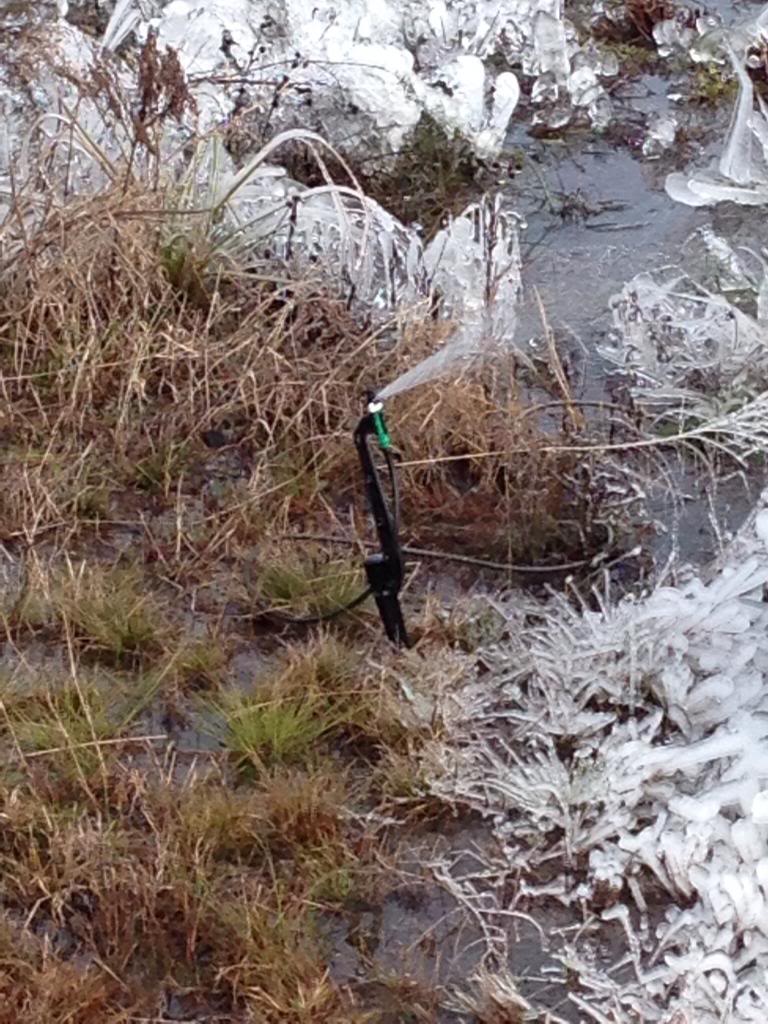| Author |
Message |
babranch
Citruholic

Joined: 06 Jan 2013
Posts: 42
Location: Manor, Georgia
|
| Posted: Sun 12 Jan, 2014 1:38 am |
|
Here are some pictures from my freeze protection earlier this week
[/img] 
[img] 
[/img] 
[img] 
[/img]  |
|
| Back to top |
|
 |
citrom
Citruholic


Joined: 06 Feb 2012
Posts: 95
Location: Hungary, Europe, Zone 6
|
|
| Back to top |
|
 |
Tom
Citruholic

Joined: 11 Nov 2008
Posts: 259
Location: Alabama [Central]
|
| Posted: Sun 12 Jan, 2014 4:15 pm |
|
He did it because there were predicted freezing temps much below what he felt was safe for his trees. The idea of ice from water sprayed on trees during freezing temps is that the water freezes at 32* F or 0* C. The ice insulates the trees and keeps the temperature inside the ice at about 30* F so much less damage occurs to the vegetation.
The pictures are very dramatic and it is scary. Some damage can still occur. The trees are very susceptible to limb breakage from the added weight of the ice. If somebody comes by and breaks off the ice the whole tree could shatter apart. That would be very bad.
The ice itself doesn't hurt too much. Hopefully the water from the melting ice will drain away fairly quickly so there shouldn't be any root damage from the water.
Again the main reason for the ice was to protect the trees from extremely low temps that were imminent and for probably a long duration.
I hope that makes sense. It is a counter intuitive practice.
I had a son in Diosd for several years. You have so many extremely cold days in Hungary this would probably not be advised for you. It is more for unusual cold snaps in a more moderate climate. You have a very beautiful country !
Tom
_________________
Tom in central Alabama |
|
| Back to top |
|
 |
babranch
Citruholic

Joined: 06 Jan 2013
Posts: 42
Location: Manor, Georgia
|
| Posted: Sun 12 Jan, 2014 5:13 pm |
|
I did it because the weather consulting company that I subscribe to had the temperature forecast for my area at 13*F for Monday night and 16*F for Tuesday night. Thankfully they were wrong. Monday night I got down to 16*F the first night and 18*F the second. The water ran from 5:40 p.m. Monday until 5:00 p.m. Wednesday. I turned on very early because the wind had the wet bulb temperature near freezing by that time, and I wanted a good base layer of ice to form. After running for nearly 48 hours, I only had two very small twigs break on two of the 27 plants.
The ice doesn't necessarily "insulate" the tree. If I would have let it run until the ice was formed and then turned it off, the damage would have been as bad as not turning it on at all. In blueberries we have seen this happen to fields where the pumps went down in the middle of the night. The way ice protects is by releasing heat as the water freezes, but you have to be applying enough water for this process to continue. My setup applies .5 gallon/minute/tree, and the sprinkler is positioned with the direction of the prevailing wind. It is a bit overkill, but I'd rather be safe than sorry. |
|
| Back to top |
|
 |
citrom
Citruholic


Joined: 06 Feb 2012
Posts: 95
Location: Hungary, Europe, Zone 6
|
|
| Back to top |
|
 |
Lemandarangequatelo
Citruholic


Joined: 01 Mar 2010
Posts: 475
Location: UK
|
| Posted: Mon 13 Jan, 2014 7:22 am |
|
Thanks for explaining, that's great info to have.
Could you modify the technique to spray onto frost cloth wrapped wire cages instead of directly onto the trees?
Another idea that occurred would be to use the running water to instead run a generator which powers small heat sources under the trees, which are covered by frost cloth/plastic wrapped cages. That's assuming there's no electricity supply available in the field.
I guess the advantage of this method though is that you don't have to set up any cages or heating systems, you just use the watering system for this purpose when needed. |
|
| Back to top |
|
 |
yuzuquat
Citruholic

Joined: 01 Sep 2013
Posts: 114
Location: manchester, england
|
| Posted: Mon 13 Jan, 2014 5:17 pm |
|
Method is generally not used in uk or the milder parts of Europe because our temperatures tarely get cold enough, quickly enough and for long enough.
The method is applied in the southern US because they will get sudden weather systems that blow in bringing arctic temperatures deep into the citrus growing areas e.g. Florida.
Trees are in active growth when the front moves in and daytime temps drop from the 80"s into the 20's. The freeze may last from a few hours to a few days.
Using sprinklers is a good way to protect a tree of 8-12ft.
In UK I doubt if you have trees of that size. If you are growing less cold tolerant vatieties they are better off in greenhouse that can be kept frost free. If you are growing the more cold tolerant types the fleece I identified to you will be adequate for most winter weather in UK.
If our weather does come in from Iceland or Siberia, usually 1year in 10, christmas tree lights under the fleece should raise the temp enough to avoid damage. Just be sure you get the old fashioned inefficient types that give off heat not LEDs.
Now's a good time to buy whilst in sales.
Our winter has been so mild so far that I took mine out from the fleece. No frosts forcast tilmid feb and then not loerr than -3*c. May need to bring microcitrus indoors then. |
|
| Back to top |
|
 |
babranch
Citruholic

Joined: 06 Jan 2013
Posts: 42
Location: Manor, Georgia
|
| Posted: Tue 14 Jan, 2014 2:56 am |
|
Lemandarangequatelo,
Those are all great ideas, but counter intuitive for what I'm doing. Plus having a pump that runs off of one fuel source (petroleum based or electrical) run water to power a generator to create electricity doesn't make sense to me. These trees were planted as a small test plot of different varieties to see what would survive using commercially available equipment.
The cost per tree for the micro spray and supply lines is less than $2 and only takes a couple minutes per tree to set up. To build wire cages, anchor them, and attach frost cloth to them seems like it would take a long time and cost more, even on the 27 trees that I have currently planted. By spraying the water on the covered cage, most of the heat would either be pulled away by the wind or radiate upwards. The ice needs to be forming very close to the plant tissue in order for it to have any positive effect. If I was only protecting these for personal consumption and not trying to look at testing a commercially feasible option, I might consider testing some of the methods that you presented.
A friend of mine planted 10 acres of satsumas about 15 miles from me and tried protecting using different methods, and the trees that were iced over throughout the freeze faired much better compared to Christmas lights and/or covering with plastic. |
|
| Back to top |
|
 |
Tom
Citruholic

Joined: 11 Nov 2008
Posts: 259
Location: Alabama [Central]
|
| Posted: Tue 14 Jan, 2014 4:10 am |
|
Dallas Hartzog in SE Alabama is using about 144 inches of spaghetti drip tubing wrapped around each Satsuma tree and he puts a micro mister in the tree pointed north. My notes say the round emitter is 1 or 2 feet above the ground and it sprays 14 gallons of water per hour. He says the long tube has enough water running through it to help keep the trunk warm and the ice protects the limbs and foliage. He talked about it at the SE Fruit Expo. He is a very smart hard working man. He has a very interesting operation.
He also has a very unique marketing plan. He sells all his fruit to the public in one day. He does sell large orders privately at other times as necessary such as for a school lunch program. All his trees are Owari. Tom
_________________
Tom in central Alabama |
|
| Back to top |
|
 |
Lemandarangequatelo
Citruholic


Joined: 01 Mar 2010
Posts: 475
Location: UK
|
|
| Back to top |
|
 |
Millet
Citruholic


Joined: 13 Nov 2005
Posts: 6657
Location: Colorado
|
| Posted: Wed 15 Jan, 2014 12:24 am |
|
The packaging on the product seems rather homey in appearance. Interesting that no information of any kind is provided by the seller at approximately how low of a temperature the product is expected to give additional protection. Also, I notice that the seller does not give any information on what size the trees are that he is offering for sale. - Millet |
|
| Back to top |
|
 |
babranch
Citruholic

Joined: 06 Jan 2013
Posts: 42
Location: Manor, Georgia
|
| Posted: Wed 15 Jan, 2014 1:02 pm |
|
We sometimes use a product called Vapor Gard that is manufactured by Miller Chemical and Fertilizer company. It is similar to the Liquid Frost Cloth in that they are both anti-transpirant products. They work by preventing the desiccation of green tissue on windy nights, and keep frost from forming on still nights. With this type of product, coverage is essential. Any bare spots on non-woody growth will suffer. At best, these products will help down to around 20-25*F on tissue that is normally damaged at 32*F. Once it goes below that point, ice will form within the cell walls and cause the cells to rupture. |
|
| Back to top |
|
 |
MarcV
Moderator


Joined: 03 Mar 2010
Posts: 1479
Location: Schoten (Antwerp), Belgium
|
| Posted: Tue 21 Jan, 2014 6:29 pm |
|
I must have missed this thread! That's a really beautiful, surreal landscape!
_________________
- Marc |
|
| Back to top |
|
 |
buddinman
Citrus Guru

Joined: 15 Nov 2005
Posts: 342
Location: Lumberton Texas zone 8
|
| Posted: Thu 23 Jan, 2014 1:52 am |
|
From what i have been told from the real experts it is best to leave the water run until the air temp get above 32 degreess F. As water freezes it gives off heat. |
|
| Back to top |
|
 |
babranch
Citruholic

Joined: 06 Jan 2013
Posts: 42
Location: Manor, Georgia
|
| Posted: Thu 23 Jan, 2014 2:31 am |
|
Buddinman,
I run my water until the wet bulb temperature gets above 32, or until all of the ice has melted. Believe it or not, but ice can fall below freezing. If the winds are high the effect is worse. The reason for continuing to run water instead of just turning off is because the ice melts faster with 62 degree water.
Wet bulb temperature is what I also use to determine when I turn on. If I'm going to run water, I turn on when the wet bulb is 33-34 degrees. In my observations in blueberries this has resulted in better initial ice formation and lower overall damage. The base layer needs to be clear and free of any air bubbles to evenly conduct the heat generated by new ice formation. The tops of the trees in the pictures that had cloudy ice also had damage.
Marc,
It's nice and quiet most of the year. Only one neighbor within 1/4 of a mile. |
|
| Back to top |
|
 |



























